Latin name: Nerine
Category: herbaceous bulbous plants
Origin: South Africa
Nerine – an exotic representative of the flower beau monde
Nerine (Nerine) – the genus is represented by beautiful and amazing bulbous cultures with unique and elite aristocratic manners, which has proven itself in the Amaryllis family.
The floral elite of this unique family consists of such unsurpassed and spectacular plants as gemanthus, hymenocallis, zephyranthes, clivia, krinum, eucharis and many other interesting exotics.
The tribal community of Nerine in its composition has thirty different varieties of plants that have acquired the status of the most capricious of all amaryllis. They require constant attention and care in the care. The warm climate of most regions of the globe allows nerina to smell fragrant, to present its beauty of lush flowering and the voluptuousness of a pleasant aroma in open areas of squares, gardens, streets, summer cottages.
The beginning of the last century is for the Nerina the moment of its cultural cultivation.
The cool climate of most areas can provide only indoor greenhouse conditions for a tropical beauty, a flower will look wonderful and ennoble the interior of terraces, balconies, various public buildings, summer gardens, greenhouses.
Very often, florists use this miracle, bewitching with its beauty, in the preparation of various compositions.
The Cape of Good Hope with its tropical forests, which is located in South Africa, is home to this magnificent decorative flowering perennial plant.
The beautiful nymph Nereis (Nereid) from the mythology of Ancient Greece served as the prototype for the interesting name of the flower of the same name.
This most beautiful flower of Nerina is also called the graceful beauty, the lily of Guernsey, the flower of the Nymph, the Cape flower.
Often this tropical beauty responds to the bizarre nickname spider lily, which she received due to her bizarre, interestingly curved beautiful petals.
The exotic lily Nerine is endowed with its own individual exterior with a height of thirty to eighty centimeters.
The plant has belt-like, dark green, flat, linear leaves, reaching thirty centimeters in length.
The unique root is represented by an elongated bulb, which gives rise to the germination of a long stem. The process of the appearance of a fifty-centimeter peduncle occurs simultaneously with the appearance of leaf plates. The thickness of the stalk can be three or five centimeters.
These strict forms of the peduncle are ennobled by a large umbrella-shaped inflorescence.
It is organized by four-centimeter flowers with narrow petals bent back, edges that have an original waviness and chic erect stamens. The number of flowers in each inflorescence can vary from seven to fifteen pieces. The color range of these unique flowers rolls over. They come in white, pink, red, rich crimson or orange colors.
The flowering culture of nerina in the autumn period attracts the eye not only with charming beauty, but with a heavy, pleasant aroma.
While admiring this unique exclusivity, it must be remembered that the insidiousness and deceitfulness of culture lies in its toxicity.
Nerina is poisonous.
It is necessary to communicate with the plant using protective gloves and exclude access of animals and children to the plant.
A bulbous flower with long narrow leaves delights with a variety of varieties and varieties. Thirteen types of culture can boast of natural origin and growth in natural conditions. The work of breeders was very successful and about thirty more hybrid individuals of this flower appeared. They are bright and unusual specimens, all display their own zest, each species is worthy of individual consideration.
Nerine species
Nerine Bowdenii (Nerine Bowdenii)
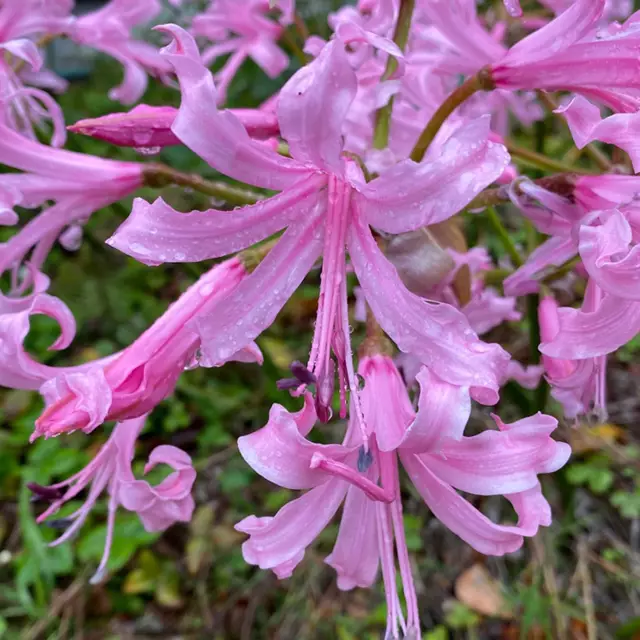 The mountainous South African territories are home to this species, popular in home floriculture.
The mountainous South African territories are home to this species, popular in home floriculture.
This variety of nerina appeared in the European part of the globe in one thousand nine hundred and three thanks to Cornish Bowden, whose name this exotic beauty bears.
The culture proved to be hardy and cold-resistant. It will feel great on personal plots in open ground conditions.
Nerina Bowden is also called the "flower of the nymph."
Bulb-shaped roots of a bottle configuration reach a volume of five centimeters, a larger segment of which is above the soil level.
Long thirty-centimeter leaves give life to a false stalk about 5 cm long. The upper glossy side of the grooved leaves, gradually tapering towards the top, is painted with a huge number of veins. The peduncle reaches almost half a meter in height. The umbrella-like inflorescence is made up of pink lily-like flowers. Their number in each inflorescence is different – from six to twelve pieces. Very beautiful, bright and spectacular nerina is very highly rated among flower growers and is not inferior to such beauties as Orchid plants.
Mid-autumn is the flowering period of this variety.
Nerina Bowden West looks very nice in the form of a cut bouquet. In a vase, it can give beauty for up to three weeks.
Nerine Sinuous (Nerine Flexuosa)
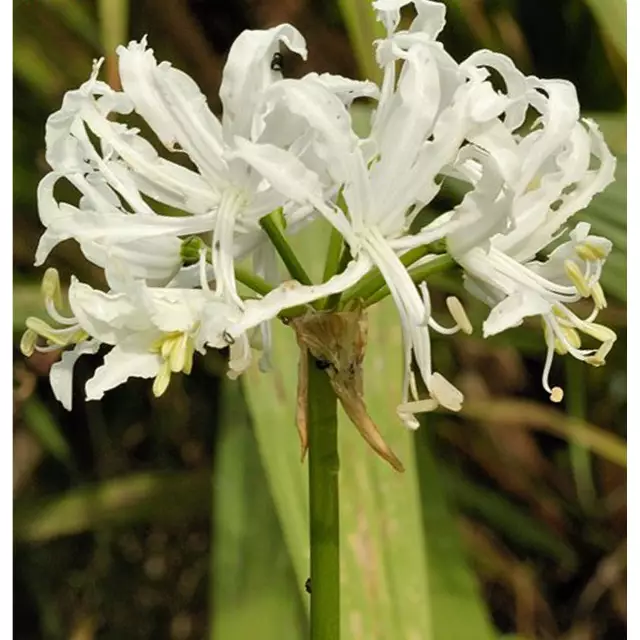 A beautiful variety of Nerine Sinuous blooms with pink or white inflorescences. Flowers-bells have original wavy petals. This spectacular beauty is located on tall peduncles.
A beautiful variety of Nerine Sinuous blooms with pink or white inflorescences. Flowers-bells have original wavy petals. This spectacular beauty is located on tall peduncles.
Nerine Curvifolia (Nerine Curvifolia)
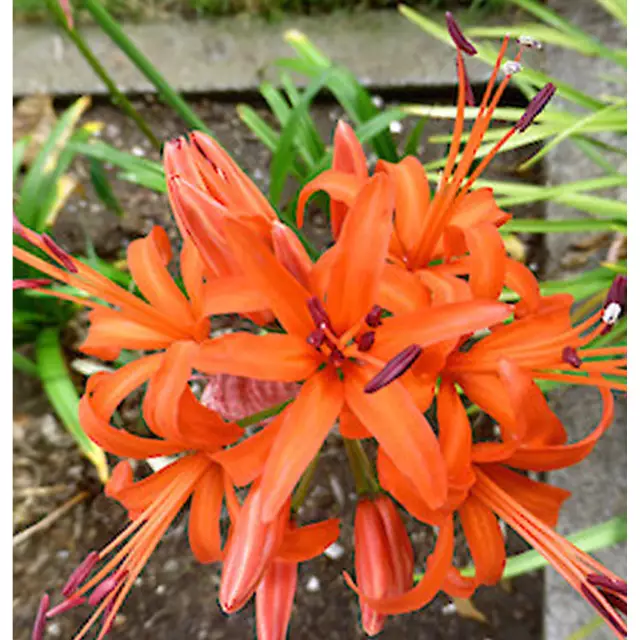 Very original and beautiful view, has dark leaves of a lanceolate-linear configuration.
Very original and beautiful view, has dark leaves of a lanceolate-linear configuration.
An individual feature of the leaf plates is that they stop growing, reaching their maximum only after the end of the flowering period.
On a forty-centimeter peduncle there are inflorescences in the form of an umbrella, which are collected from twelve flowers resembling a lily. Flowers with red, shiny petals and long stamens look very colorful.
Nerine Shameful (Nerine Pudica)
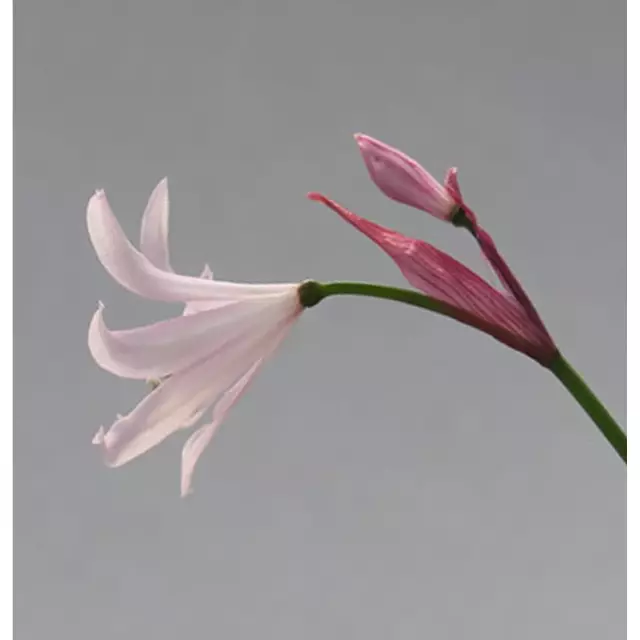 The culture is decorated with four to six pieces of elongated leaves with a greenish-gray tint. The bulbs of Nerina Shameful reach a diameter of three centimeters. Nerine white has an individual feature. The number of flowers on the peduncle does not exceed six pieces. But the attraction and beauty of this spectacular miracle does not diminish.
The culture is decorated with four to six pieces of elongated leaves with a greenish-gray tint. The bulbs of Nerina Shameful reach a diameter of three centimeters. Nerine white has an individual feature. The number of flowers on the peduncle does not exceed six pieces. But the attraction and beauty of this spectacular miracle does not diminish.
Nerine Sarniensis (Nerine Sarniensis)
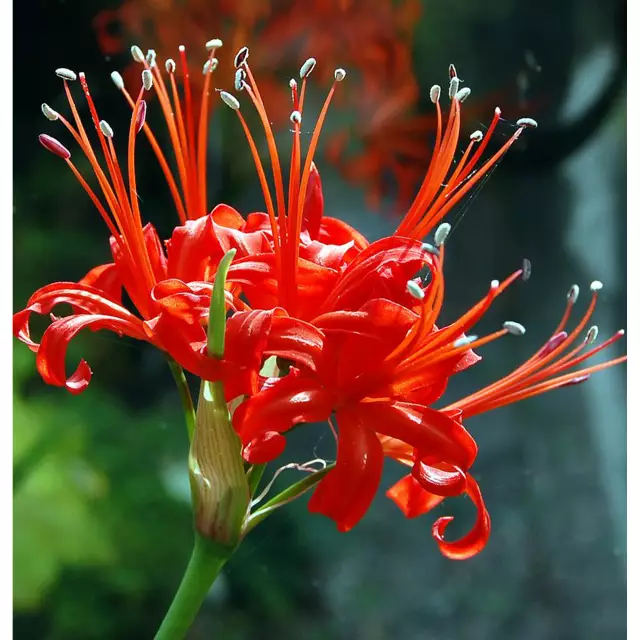 This original species blooms with large white, orange, red flowers that perfectly decorate the top of the peduncle. The uniqueness of the flowers – their beauty lies in the narrow and interestingly twisted petals.
This original species blooms with large white, orange, red flowers that perfectly decorate the top of the peduncle. The uniqueness of the flowers – their beauty lies in the narrow and interestingly twisted petals.
Nerina home care
The nerine flower wants more attention than other houseplants. But this is a troublesome business and all the efforts spent during care are offset by its unsurpassed beauty and attractiveness.
The main thing is to fulfill all the requirements and desires of your pet, trying to create optimal living conditions for him, to which he is accustomed to in his natural habitat.
Choice of location and temperature
Spider lily wants to be in a lighted area, but can put up with a slight penumbra. Everything in moderation will be pleasant for the flower. The best places for it will be directions from the southwest, east or west. The rays of the direct sun should preferably illuminate the graceful beauty in the morning.
If the plant feels a lack of light, the response will be the absence of flowering.
In the warm off-season, the Nymph flower wants to be in warm conditions with a temperature within 20 ° C. In the winter period, which is marked by the laying of buds for flowering in the plant, the temperature should not exceed 10-12 ° C. A flower in winter can be content with an insulated loggia or a dry basement. After the leaves have dried, they must be removed and the flowerpot with nerine should be placed in the refrigerator before March, defining a shelf in the lower section for it. The blooming Cape flower will happily enjoy temperatures around 15°C in autumn.
The lower the ambient temperature, the airspace should be drier and vice versa.
Humidity and watering
Tropical beauty wants high humidity. If the temperature regime has exceeded the fifteen-degree barrier, the Nymph flower is sprayed. In a pallet with wet expanded clay or pebbles, a tropical exotic will feel great.
Waterlogging and accumulation of moisture in the flowerpot can lead to rotting of the nerine bulb.
For Guernsey lilies in bloom, the potting mix should be slightly damp, a suggested watering interval of four days. With the end of the flowering period, water once every seven days. A dormant houseplant is not watered at all.
Soil and its top dressing
Lily Nerine will be content with a loose substrate with a slightly acidic reaction, in which a low content of nitrogenous compounds, which will allow the plant to bloom better.
For individual preparation of the soil mixture, it is necessary to take in equal proportions: old clay, sand, compost soil or humus, bone meal in a small amount. For 10 kg of the mixture, you can add chalk to reduce the acidity of the soil, about eight grams of potassium sulfate, about 25 grams of superphosphate.
The bottom of the flowerpot with a hole should be laid with a thick drainage layer.
Bulbous plants in pots during the growing season need to be fed with liquid complex fertilizers that contain phosphorus and potassium compounds at intervals of fourteen days. After flowering and all winter, the plant is not fertilized.
Nerina transplant
To transplant a spider lily, you must use a shallow flowerpot with a diameter of thirteen centimeters. How to plant bulbous flowers in pots?
The bulb should be buried in the soil by two-thirds of its size.
With the onset of August, it is necessary to start this procedure. Two onions can be planted in a pot with fresh soil. If the planting process was successful, then in thirty days the plant will delight with flower stalks with original buds.
Nerine reproduction
Getting a fresh Guernsey lily is easy with seeds and daughter bulbs.
Baby bulbs are planted in separate small pots. Care is carried out as for an adult plant. Flowering seedlings will delight in two or three years.
Freshly harvested seeds are sown in the soil at a distance of two centimeters from each other. Moisten the soil and create greenhouse conditions with regular ventilation. Within one month, it is necessary to wait for the emergence of seedlings. Young seedlings with several leaves on the stem should be planted in separate flowerpots.
Pests and diseases
If the growing conditions are violated, a bulbous flower with long narrow leaves can be visited by uninvited guests in the form of aphids, mealybugs, thrips, root mites. If these unpleasant individuals are found, it is necessary to treat the plant with a soap or alcohol solution, pour the flower with a solution of potassium permanganate.
If these misunderstandings continue after treatment with gentle means, it is urgently necessary to destroy the pests with insecticidal preparations.
Difficult Growing Moments
- The leaf plates are covered with a light bloom – these are signs of powdery mildew. An urgent treatment of a houseplant with a fungicide is necessary.
- The leaves of the nerine were covered with brown spots – the plant was exposed to the mosaic virus due to a violation of the conditions of detention. To combat the disease, we use fungicidal preparations.
- Nerine leaves turned yellow – it is necessary to increase the humidity in the room.
- A houseplant is intensively gaining green mass, and there is no flowering – an overabundance of fertilizers.
- Bulbs rot – excessive watering.
An amazing, exotic tropical beauty has its own requirements for its content. But it's worth it. Observe the main subtleties of growing, show attention and caring attitude to your pet. The spider lily will reward you with a chic and unique flowering, decorative beauty, and will decorate any interior with its presence.
Nature is very diverse and rich in various unusual vegetation. Many indoor plants with photos and alphabetical names can be seen by going to the catalog.
Happy viewing!




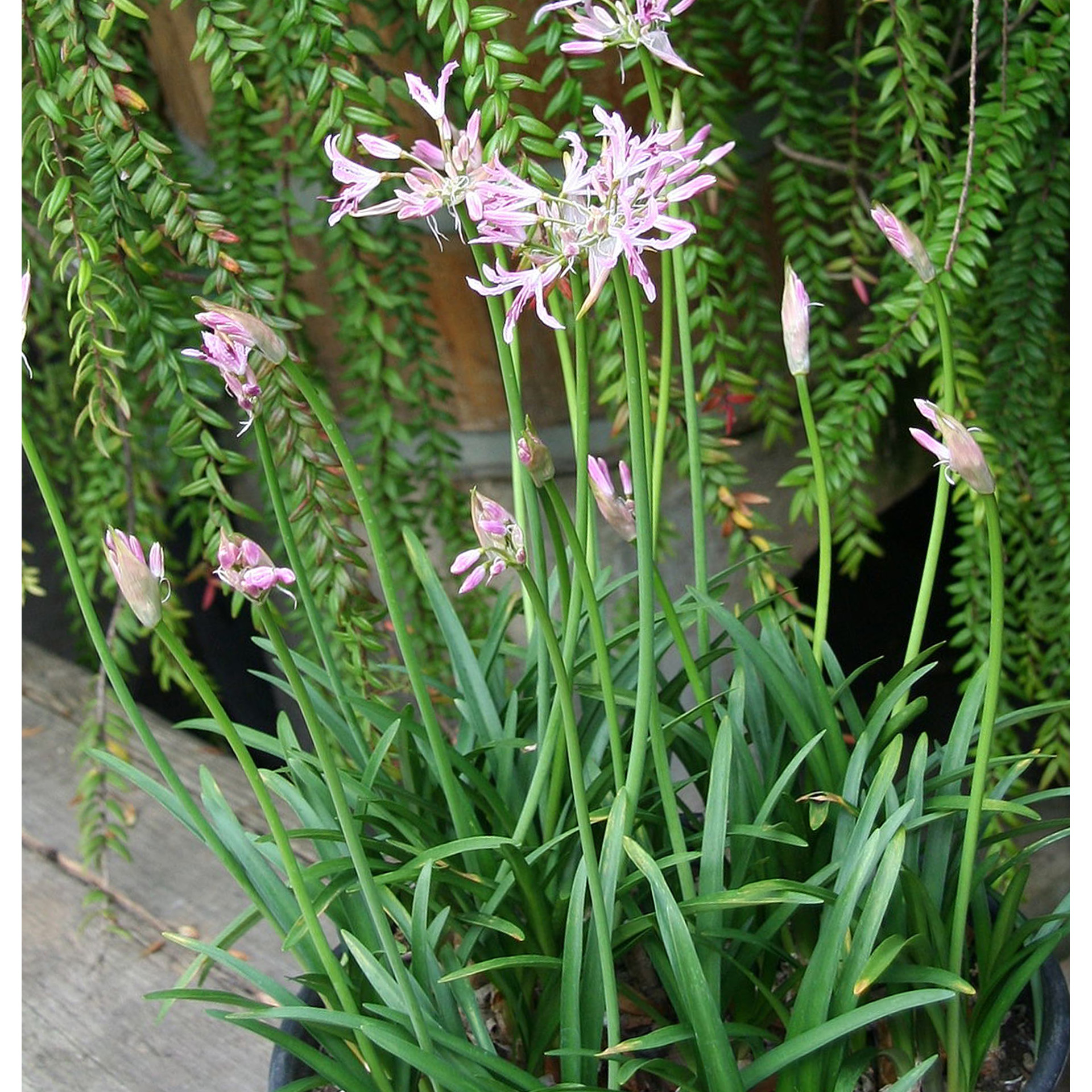










Write comments
Comments